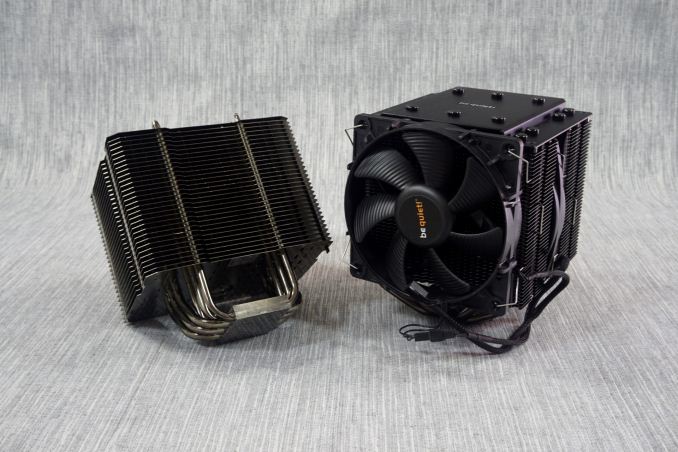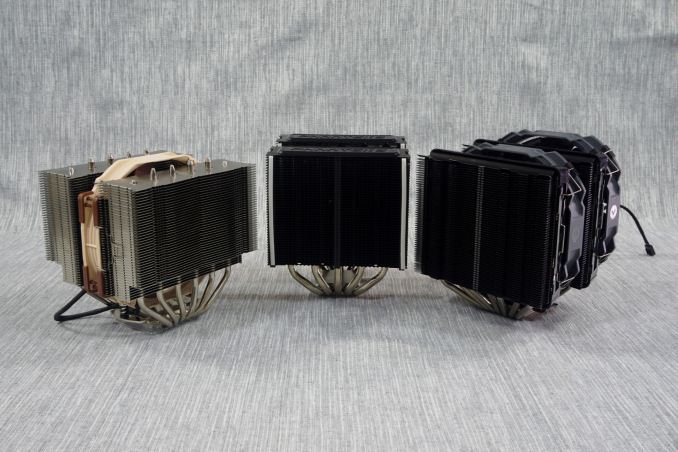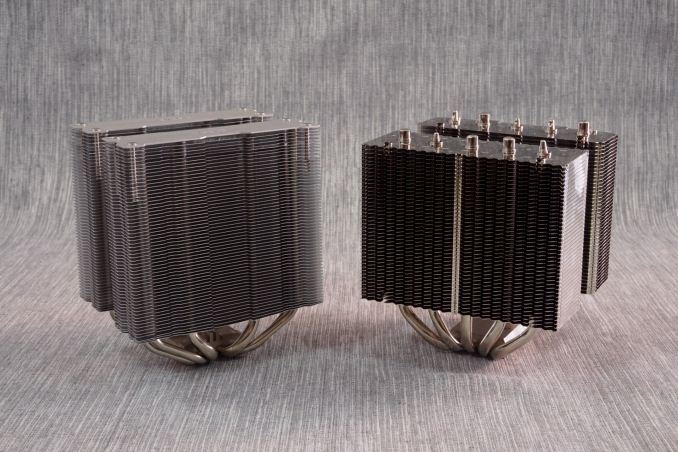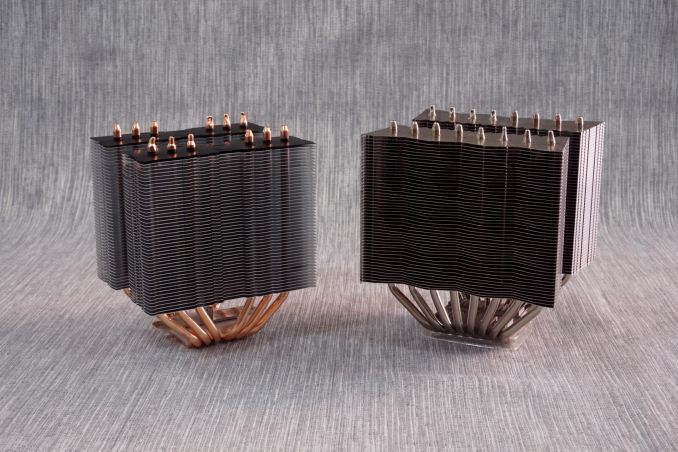Top Tier CPU Air Coolers Q3 2015: 9-Way Roundup Review
by E. Fylladitakis on July 6, 2015 8:00 AM ESTConclusion
It goes without saying that the selection of a CPU cooler is not easy. Each user has different requirements and needs. Even if we select a very specific group, such as those who are seeking the best air-based cooling solutions possible, there are different levels of tolerance to noise and different budgets. Furthermore, certain coolers could cause compatibility problems with the case or the RAM. All performance and physical aspects need to be taken into account by each individual user, weighing which option is the best for a specific application.
If thermal performance were the top priority, it would be very difficult to select between the Noctua NH-D15, the Cryorig R1 Ultimate, the Phanteks TC14PE and the Raijintek Tisis. All four of these coolers have similar thermal performance overall, with the Tisis and the NH-D15 showing a little better performance at lower loads and slightly lower noise levels. All four of these coolers are of comparable manufacturing quality as well; at least as long as the body of the cooler is concerned. A selection between these four coolers generally becomes a matter of compatibility, availability and pricing.
Noctua and Phanteks are known for their support and their willingness to offer mounting kits for new sockets, plus their design allows their front fans to be raised and increase the RAM clearance, gaining several points on compatibility. Cryorig's R1 Ultimate is visually very lustrous but its availability is extremely low. Furthermore, its plastic frame design prevents the fan to be moved up more than a few mm's, limiting RAM compatibility beneath the cooler. The Raijintek Tisis has the advantage of lower pricing but its availability is limited and its fans cannot be adjusted in terms of height at all.
When thermal performance becomes the only priority, the Reeven Okeanos overtakes the competition through sheer force. The relatively small and simple cooler hits the top of our thermal resistance charts, demonstrating the best thermal performance of this roundup review. However, this performance is solely based on its high speed fans, making the Okeanos by far the loudest cooler of this review as well. Furthermore, its availability is very low as Reeven still has very low market penetration and production. It would be easy to recommend the Okeanos to those who do not care about noise at all, but the blunt truth is that everyone does care about noise. It may not be the first priority but it definitely is a major selling factor, as nobody likes a noisy device, limiting the potential of the Okeanos.
Be Quiet!'s Dark Rock Pro 3 is clearly designed with acoustics and quality as the priorities, which generally are the focus and trademark of the company. It may be falling a little behind on thermal performance but it does deliver the promised lower noise levels. Furthermore, it is a high quality construct and comes with very high quality fans, improving its competitiveness. The acoustics performance of the Dark Rock Pro 3 is only challenged by the irregularity of our review, the Thermalright Macho Zero, a cooler designed for very low airflow environments. When paired with Thermalright's own TY-147A fan, the Macho Zero cannot offer the same thermal performance as the rest of the coolers but it is practically noiseless. Its wide fin spacing has very low airflow impedance, making the cooler optimized for semi-fanless operation. This means that the Macho Zero is designed to rely on the airflow of a case and operate without a fan at all, or to operate with a high-CFM case fan installed on it. Because of the low airflow impedance, the noise level of the Macho Zero is notably lower than that of conventional coolers, while it does offer good thermal performance. For those that acoustics are a primary concern, the Macho Zero definitely holds a major advantage.
The last two coolers of this review are the SlientiumPC Grandis XE1236 and the Deepcool Assassin. The former is by far cheaper than any other solution of this review and, considering its thermal performance, we wonder if it would be more reasonable to compare it against middle-range coolers, not the largest and mightiest behemoths out there. The only real comparison with the rest of the coolers in this review is its size and dual tower design. SilentiumPC however does not exaggerate, openly claiming that the primary design factor of their products is cost. True enough, the Grandis XE1236 is very competitively priced and offers acceptable overall performance, making it a very interesting solution for users on a tight budget. The Deepcool Gamerstorm Assassin is a more complicated matter. The design, size and, until recently, the price of this cooler were hinting that the Assassin is on par with the best coolers out there. However, despite its grandiose appearance, the Assassin generally fails to impress and it would be in great trouble if a massive price cut would not take place just a few days ago. With its retail price reduced by 25-30%, the Assassin becomes a viable solution, competing in terms of value rather than performance, making it a higher quality solution over the Grandis at an acceptable cost.
Ultimately, if our conclusions could be summarized in a single table, it would be this:
| 9-Way CPU Cooler Quick Conclusions | |||
| Priority | Cooler | Reason | |
| Best Thermal Performance |
Noctua NH-D15 $93 |
Reeven Okeanos 60€ (≈$54*) |
If raw thermal performance is the only concern, these two air-based coolers offer the best there is. Arguably, the Okeanos is far too loud but, even though the high performance solely comes from strong fans, it retails for nearly half the price of the NH-D15. Therefore, the final selection depends on secondary targets and the budget. |
| Quietest | Thermalright Macho Zero $65 (no fan) |
Be Quiet! Dark Rock Pro 3 $86.50 |
When low noise is the primary selection factor, Thermalright wins hands down. Be Quiet!'s Dark Rock Pro 3 would be our next choice, as it is a complete solution with fans and offers better thermal performance at comparatively low noise levels. |
| Best Value | SilentiumPC Grandis XE1236 £34.90 (≈$45*) |
Phanteks TC14PE $80 |
Out of the nine coolers of this review, the Grandis may not be the best performer but it is by far the cheapest. For those that are satisfied with good performance and just want a good cooler, it will not disappoint. For those in the US, Phanteks' TC14PE offers very good quality and performance at a competitive price. |
| Realistic selection (or what I, as an enthusiast/overclocker, would buy) |
Noctua NH-D15 $93 |
To my eyes, Noctua's NH-D15 is the most balanced product of this review. It offers excellent thermal performance at reasonable noise levels, the quality is exceptional, all while the retail price is not extravagant. | |














135 Comments
View All Comments
marraco - Monday, July 6, 2015 - link
Something really important that never is reviewed is dust control and maintenance.As radiator fins get closer, they have more dissipation area, but air flow gets worse. Yet the main problem of fins closeness is that they accumulate dust much faster, and get occluded.
No review makes a dust test. I have a Thermaltake cooler, which works excellent when is clean, but it rapidly loses his capacity due to being occluded by dust.
The easiest way to remove his dust is to use canned air, but it is a short lived fix, because an air cleaned radiator occludes itself very fast, sometimes in matter of weeks.
The only way to clean it for good is to take out the dissipator, and put in in the dish washer. But that is a cumbersome task. I need to do a lot of work just to clean it, and I need thermal paste to place it again on the motherboard.
So, maintenance is as important as cooling and noise.
A good cooler should pass a dusting test (being exposed to a day of dirty and dusty air current), and should be possible to clean it without much hassle, without applying thermal paste, without using screws, without need to access both sides of the motherboard, and without his pegs breaking or being degraded by manipulation.
'nar - Tuesday, July 7, 2015 - link
Interesting concern. It makes sense, yet is never considered. I think the best answer is the same as electricity, you need to provide the best environment you can for your computer. Higher quality components are more sensitive to dirty power, and dusty air. Get that PC off the floor, and get a case with good dust filters. And if your room is bad enough, get an room air filter. I have one on my desk right in front of my PC. A Honeywell HEPA air filter.Impulses - Monday, July 6, 2015 - link
I understand why cases are tested with stock fans, replacing 3+ quality fans will significantly alter the price equation... It's a trivial difference for $50-100 heatsinks tho, many are often even sold sans fans anyway.If nothing else, a single apples to apples test with all running the same fan would've been welcome. In addition to something like the Hyper 212 as a baseline, the different Thermalright TRUE Spirit variants have remained a solid value over the years (they perform better than the 212 and even closer to some of these as per HardOCP's last roundup).
Is there gonna be a midrange roundup? Spending upwards of $65 on an air cooler never made much sense to me when more affordable options were so close in both noise and performance. Out of 9 coolers tested only 3 or so come in at a sensible price, at $75+ wouldn't it make more sense to go AIO WC?
xthetenth - Monday, July 6, 2015 - link
If you want low noise, good thermals and dead quiet idle well into the land of diminishing returns, high end air is still a very compelling alternative to water, especially if you're willing to put the effort into some ducting.However midrange products can be excellent and are well worth a good long look before hanging a hundred bucks off your socket.
'nar - Tuesday, July 7, 2015 - link
I was a HSF fanboy until I actually needed a water cooling system. Specs and testing does not show response time. Fast, transient loads can overwhelm a HSF, as heat pipes cannot transfer heat as fast as water. For low power CPU's a HSF is fine, but when you go over 100 watts the noise is less of an issue, as a HSF will need much more airflow to compare to the higher heat transfer ability of W/C. And instantaneous loads are more likely to cause system instability due to the less efficient heat transfer rates of heatpipes.meacupla - Tuesday, July 7, 2015 - link
I am going to nitpick on what you're saying there, because you have it confused.Heatpipes use some form of vaporized liquid inside and they actually transmit heat quite good, especially when compared against sold copper rods. Where they fail, is that they do not have a lot of capacity for transferring large amounts of heat.
Water is actually quite poor at transmitting heat, as it's a non-metal and an insulator. It does, however, have great capacity to hold heat.
This is why large bodies of water are warm during winter and cold during summer and results in mild weather near the coast and extreme weather in the interior.
The advantage of water cooling systems, over air cooling, is the ability to place large radiators, with a lot of surface area, in spots that get fresh air from outside the case, instead of warmed up air that is already inside the case. Heatsinks are also limited to size and weight constraints around the socket.
Were it possible to attach a triple 120mm fan heatpipe heatsink, as in parallel layout, instead of serial dual towers, directly to the CPU, I'm quite sure the results would be similar to a 360mm radiator water cooling setup.
xthetenth - Tuesday, July 7, 2015 - link
Yeah, he's describing the thermal mass of the coolant, not any transfer capability. It seems that running coolant through radiator fins does have an advantage of relying on the fins to radiate the heat out from a heatpipe, but for a similar surface area, it's questionable how large the advantage is, especially at CPU TDPs.GPUs on the other hand have a more constrained form factor for large air cooling and a higher TDP, so they are a more promising place for CLCs.
PitneFor - Monday, July 6, 2015 - link
wheres Prolimatech, my precious...mejobloggs - Monday, July 6, 2015 - link
I'd be very interested to see a size-per-performance chart.I usually buy coolers that perform the best without being too large. Although I guess "Top Tier" coolers isn't the right article to look for smaller size coolers :p
Impulses - Monday, July 6, 2015 - link
Leaving it to the manufacturers to select their entry is always messy or questionable IMO, TR choosing the Macho over the Silver Arrow for one... Still curious whether there's a midrange round up planned or if this is it for air coolers at AT for a couple more years...Despite the criticism I do appreciate E Fyll's thorough process, otherwise I imagine I and many others wouldn't even bother commenting. Low end (212+) and high end ($120 AIO?) base lines would make the article much more useful tho.
The into even suggests some people prefer high end air over WC at the start but then leaves that up in the air... No pun intended.